Ancient Piece of Art From Dhi Qar Province Iraq Called Umma
 | |
| Lagash Shown within Near East Show map of Near East Lagash Lagash (Iraq) Show map of Iraq | |
| Location | Ash Shatrah, Dhi Qar Province, Iraq |
|---|---|
| Region | Mesopotamia |
| Coordinates | 31°24′41″N 46°24′26″E / 31.41139°North 46.40722°East / 31.41139; 46.40722 Coordinates: 31°24′41″N 46°24′26″E / 31.41139°N 46.40722°Eastward / 31.41139; 46.40722 |
| Type | Settlement |
| Expanse | 400 to 600 ha |
| History | |
| Founded | 3rd millennium BC |
Lagash [4] (cuneiform: 𒉢𒁓𒆷𒆠 LAGAŠKI ; Sumerian: Lagaš), or Shirpurla, was an ancient city state located northwest of the junction of the Euphrates and Tigris rivers and east of Uruk, about 22 kilometres (xiv mi) due east of the modern boondocks of Ash Shatrah, Republic of iraq. Lagash (mod Al-Hiba) was one of the oldest cities of the Aboriginal Near East. The ancient site of Nina (Tell Zurghul) is around 10 km (6.2 mi) away and marks the southern limit of the state. Nearby Girsu (mod Telloh), well-nigh 25 km (16 mi) northwest of Lagash, was the religious heart of the Lagash country. Lagash's main temple was the Due east-ninnu, dedicated to the god Ningirsu. Lagash seems to have incorporated the aboriginal cities of Girsu, Nina, Uruazagga and Erim.[5]
History [edit]
From inscriptions found at Girsu such as the Gudea cylinders, information technology appears that Lagash was an important Sumerian city in the late 3rd millennium BC. Information technology was at that time ruled by independent kings, Ur-Nanshe (24th century BC) and his successors, who were engaged in contests with the Elamites on the east and the kings of Kienĝir and Kish on the n. Some of the before works from earlier the Akkadian conquest are as well extremely interesting, in detail Eanatum's Stele of the Vultures and Entemena'south nifty silver vase ornamented with Ningirsu's sacred animal Anzû: a king of beasts-headed eagle with wings outspread, grasping a lion in each talon. With the Akkadian conquest Lagash lost its independence, its ruler or ensi becoming a vassal of Sargon of Akkad and his successors; only Lagash continued to be a metropolis of much importance and above all, a eye of artistic development.
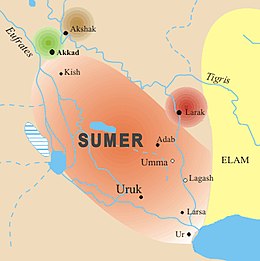
Location of Lagash before the expansion of the Akkadian Empire (in light-green). The territory of Sumer appears in orange. Circa 2350 BC

The proper name Lagash Ki (𒉢𒁓𒆷𒆠, "Country of Lagash") on inscriptions of Gudea, in awe-inspiring linear script and cuneiform script on clay.
After the collapse of Sargon's state, Lagash again thrived under its independent kings (ensis), Ur-Baba and Gudea, and had extensive commercial communications with afar realms. According to his own records, Gudea brought cedars from the Amanus and Lebanon mountains in Syria, diorite from eastern Arabia, copper and aureate from fundamental and southern Arabia, while his armies were engaged in battles with Elam on the east. His was specially the era of artistic development. Nosotros even have a fairly good idea of what Gudea looked like, since he placed in temples throughout his city numerous statues or idols depicting himself with lifelike realism, (Statues of Gudea). At the time of Gudea, the majuscule of Lagash was actually in Girsu. The kingdom covered an surface area of approximately 1,600 square kilometres (620 sq mi). Information technology contained 17 larger cities, viii district capitals, and numerous villages (about twoscore known by name). According to i estimate, Lagash was the largest city in the world from c. 2075 to 2030 BC.[6]
Soon after the time of Gudea, Lagash was absorbed into the Ur III state as 1 of its prime number provinces.[vii] There is some information about the area during the Old Babylonian catamenia. After that it seems to have lost its importance; at least we know zilch more almost it until the construction of the Seleucid fortress mentioned, when it seems to accept become part of the Iranian kingdom of Characene.
First dynasty of Lagash (c.2500-2300 BC) [edit]
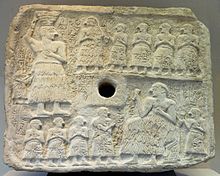
Relief of Ur-Nanshe. At the top he creates the foundation for a shrine, at the bottom he presides over the dedication (Louvre).

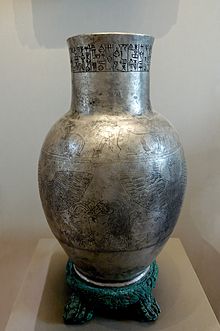
The dynasties of Lagash are not establish on the Sumerian Rex List, although one extremely bitty supplement has been found in Sumerian, known equally The Rulers of Lagash.[8] It recounts how after the flood mankind was having difficulty growing food for itself, being dependent solely on rainwater; information technology farther relates that techniques of irrigation and cultivation of barley were so imparted past the gods. At the stop of the text is the statement "Written in the school", suggesting this was a scribal school product. A few of the names from the Lagash rulers listed below may be made out, including Ur-Nanshe, "Ane-tum", En-entar-zid, Ur-Ningirsu, Ur-Bau, and Gudea.
The First dynasty of Lagash is dated to the 26th century BC. En-hegal is recorded as the first known ruler of Lagash, beingness tributary to Uruk. His successor Lugal-sha-engur was similarly tributary to Mesilim. Following the hegemony of Mesannepada of Ur, Ur-Nanshe succeeded Lugal-sha-engur equally the new high priest of Lagash and achieved independence, making himself king. He defeated Ur and captured the rex of Umma, Pabilgaltuk. In the ruins of a building attached past him to the temple of Ningirsu, terracotta bas reliefs of the male monarch and his sons have been found, besides equally onyx plates and lions' heads in onyx reminiscent of Egyptian work.[9] One inscription states that ships of Dilmun (Bahrain) brought him woods as tribute from foreign lands. He was succeeded by his son Akurgal.
Eannatum, grandson of Ur-Nanshe, made himself master of the whole of the district of Sumer, together with the cities of Uruk (ruled by Enshakushana), Ur, Nippur, Akshak, and Larsa.[9] He also annexed the kingdom of Kish; even so, it recovered its independence after his death.[nine] Umma was made tributary—a certain amount of grain beingness levied upon each person in it, that had to exist paid into the treasury of the goddess Nina and the god Ningirsu.[nine] Eannatum'southward campaigns extended beyond the confines of Sumer, and he overran a office of Elam, took the metropolis of Uru'az on the Persian Gulf, and exacted tribute equally far as Mari; nonetheless, many of the realms he conquered were oft in revolt.[10] During his reign, temples and palaces were repaired or erected at Lagash and elsewhere; the town of Nina[ citation needed ]—that probably gave its proper noun to the after Niniveh—was rebuilt, and canals and reservoirs were excavated. Eannatum was succeeded by his brother, En-anna-tum I. During his rule, Umma one time more asserted independence under Ur-Lumma, who attacked Lagash unsuccessfully. Ur-Lumma was replaced by a priest-king, Illi, who also attacked Lagash.
His son and successor Entemena restored the prestige of Lagash.[9] Illi of Umma was subdued, with the help of his ally Lugal-kinishe-dudu or Lugal-ure of Uruk, successor to Enshakushana and likewise on the rex-list. Lugal-kinishe-dudu seems to have been the prominent figure at the time, since he as well claimed to rule Kish and Ur. A silver vase defended past Entemena to his god is now in the Louvre.[nine] A frieze of lions devouring ibexes and deer, incised with dandy artistic skill, runs round the neck, while the Anzû crest of Lagash adorns the globular office. The vase is a proof of the high degree of excellence to which the goldsmith's art had already attained.[nine] A vase of calcite, besides defended by Entemena, has been plant at Nippur.[ix] Afterwards Entemena, a series of weak, corrupt priest-kings is attested for Lagash. The last of these, Urukagina, was known for his judicial, social, and economic reforms, and his may well be the offset legal code known to take existed.
| Ruler | Proposed reign | Notes | |
|---|---|---|---|
| (En-hegal) |  | c. 2570 BC | One inscription known, recording a buy of land.[11] |
| (Lugalshaengur) | | c. 2550 BC | High priest or ensi. Mentioned as Ensi of Lagash in a unique inscription on the macehead of Mesilim: "Mesilim, rex of Kish, builder of the temple of Ningirsu, brought [this mace head] for Ningirsu, Lugalshaengur [existence] prince of Lagash".[12] |
| Ur-Nanshe (Ur-nina) |  | c. 2500 BC | King ("Lugal") |
| Akurgal |  | c. 2500 BC | King, son of Ur-Nanshe |
| Eannatum |  | c. 25th century BC | Grandson of Ur-Nanshe, king, took Sumer abroad from Enshagkushana of Uruk and repulsed the armies of Kish, Elam and Mari |
| Enannatum I | | c. 25th century BC | brother to Eanatum, high priest, Ur-Luma and Illi of Umma, likewise as Kug-Bau of Kish gained independence from him. |
| Entemena |  | c. 25th century BC | Son of Enanatum I, king, gimmicky with Lugal-ure (or Lugalkinishedudu) of Uruk and defeated Illi of Umma |
| Enannatum Ii | | Son of Entemena, final member of the dynasty of Ur-Nanshe. | |
| Enentarzi | | A priest of Lagash. | |
| Lugalanda | | ||
| Urukagina | | c. 2300 BC | male monarch, defeated past Lugalzagesi of Uruk, issued a proclamation of social reforms. |
-

The cuneiform text states that Enannatum I reminds the gods of his prolific temple achievements in Lagash. Circa 2400 BC. From Girsu, Iraq. The British Museum, London
-
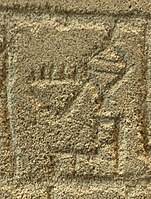
The name "Lagash" (𒉢𒁓𒆷) in vertical cuneiform of the time of Ur-Nanshe.
Border disharmonize with Umma (c.2500-2300 BC) [edit]

Vase of Male monarch Gishakidu, rex of Umma, and son of Ur-Lumma, giving the city of Umma's account of its long-running border dispute with Lagash. The vase redefines the borderland by recording the locations of stelae to the god Shara, also as the distances betwixt them. Circa 2350 BC. From Umma, Iraq. Ref. 140889, British Museum, London.[13]
In c. 2450 BC, Lagash and the neighbouring city of Umma fell out with each other after a edge dispute. As described in Stele of the Vultures the current male monarch of Lagash, Eannatum, inspired by the patron god of his metropolis, Ningirsu, prepare out with his army to defeat the nearby metropolis. Initial details of the boxing are unclear, but the Stele is able to portray a few vague details nigh the event. According to the Stele'due south engravings, when the two sides met each other in the field, Eannatum dismounted from his chariot and proceeded to lead his men on foot. After lowering their spears, the Lagash ground forces avant-garde upon the army from Umma in a dense phalanx. After a cursory clash, Eannatum and his army had gained victory over the army of Umma. Despite having been struck in the eye past an arrow, the king of Lagash lived on to enjoy his army's victory. This battle is ane of the earliest organised battles known to scholars and historians.[fourteen]
-

The armies of Lagash led past Eannatum in their conflict against Umma.
-

Lancers of the regular army of Lagash against Umma
Destruction of Lagash past the Akkadian Empire (circa 2300 BC) [edit]

Fragments of the Victory Stele of Rimush. The Victory Stele also has an epigraphic fragment, mentioning Akkad and Lagash.[fifteen] Information technology suggests the stele represents the defeat of Lagash by the troops of Akkad.[16]
In his conquest of Sumer circa 2300 BC, Sargon of Akkad, after acquisition and destroying Uruk, then conquered Ur and E-Ninmar and "laid waste matter" the territory from Lagash to the sea, and from there went on to conquer and destroy Umma, and he collected tribute from Mari and Elam. He triumphed over 34 cities in full.[17]
Sargon'due south son and successor Rimush faced widespread revolts, and had to reconquer the cities of Ur, Umma, Adab, Lagash, Der, and Kazallu from rebellious ensis.[xviii]
Rimush introduced mass slaughter and large scale devastation of the Sumerian city-states, and maintained meticulous records of his destructions.[19] Virtually of the major Sumerian cities were destroyed, and Sumerian human losses were enormous: for the cities of Ur and Lagash, he records 8,049 killed, 5,460 "captured and enslaved" and 5,985 "expelled and annihilated".[19] [20]
Stele of the victory of Rimush over Lagash [edit]
A Victory Stele in several fragments (3 in full, Louvre Museum AO 2678)[21] has been attributed to Rimush on stylistic and epigraphical grounds. 1 of the fragments mentions Akkad and Lagash.[xv] Information technology is thought that the stele represents the defeat of Lagash by the troops of Akkad.[16] The stele was excavated in ancient Girsu, one of the main cities of the territory of Lagash.[15]
-
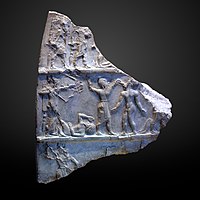
Possible victory stele of king Rimush (front).[22] Generally attributed to Rimush on stylistic grounds.[23]
-

Detail
-

Man of Lagash, circa 2270 BC, from the Victory Stele.[24] The same hairstyle can be seen in other statues from Lagash.[25]
Second dynasty of Lagash (c. 2230–2110 BC) [edit]

This catamenia lasted c. 2230–2110 BC (Middle chronology). These rulers achieved a Sumerian revival, following the rise and autumn of the Semitic Akkadian Empire, and the conquests of the Gutian dynasty.[26] The Second dynasty of Lagash rose at the time the Gutians were ruling in central Mesopotamia.[26] The rulers of Lagash, only taking the title of Ensi, or Governors, accomplished to maintain a loftier level of independence from the Gutians in the southernmost areas of Mesoptamia.[26] Under Gudea, Lagash had a golden age, and seemed to enjoy a high level of independence from the Gutians.[26]
| Ruler | Proposed reign (short chronology) | Proposed reign (middle chronology) | Notes | |
|---|---|---|---|---|
| (Lugal-ushumgal) | | 2166 – 2146 BC | 2230 – 2210 BC | Vassal of Akkadian Empire rulers Naram-Sin and Shar-Kali-Sharri |
| (Puzer-Mama) | Wrested independence from the Akkadian Empire | |||
| Ur-Ningirsu I[27] [28] | ||||
| Pirig-me or Ugme | Son of Ur-Ningirsu I.[27] [28] | |||
| Lu-Baba[29] | ||||
| Lugula[29] | ||||
| Kaku or Kakug[29] | ||||
| Ur-Baba |  | 2093–2080 BC | 2157 – 2144 BC | |
| Gudea |  | 2080–2060 BC | 2144––2124 BC | Son-in-police force of Ur-baba |
| Ur-Ningirsu |  | 2060–2055 BC | 2124–2119 BC | Son of Gudea |
| Ur-gar | 2053–2049 BC | 2117–2113 BC | ||
| Nam-mahani | | 2049–2046 BC | 2113–2110 BC | Grandson of Kaku, defeated by Ur-Nammu |
Archaeology [edit]

At the time of Hammurabi, Lagash was located about the shoreline of the gulf.
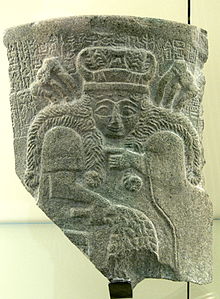
Lagash is i of the largest archaeological mounds in the region, measuring roughly three by 1.5 km (2 by ane mi) though is relatively low being just 6 meters above the plain level at maximum. Estimates of its area range from 400 to 600 hectares (990 to 1,480 acres). The site is divided by the bed of a culvert/river, which runs diagonally through the mound. The site was first excavated, for six weeks, by Robert Koldewey in 1887.[thirty] It was inspected during a survey of the surface area by Thorkild Jacobsen and Fuad Safar in 1953, finding the starting time evidence of its identification every bit Lagash. The major polity in the region of al-Hiba and Tello had formerly been identified every bit ŠIR.BUR.LA ( Shirpurla ).[31]
Tell Al-Hiba was again explored in five seasons of excavation betwixt 1968 and 1976 by a team from the Metropolitan Museum of Art and the Establish of Fine Arts of New York Academy. The team was led by Vaughn East. Crawford, and included Donald P. Hansen and Robert D. Biggs. Twelve archaeological layers were found with the bottom 9 existence Early Dynastic and the everyman under the water table. The primary focus was the excavation of the temple Ibgal of Inanna and the temple Bagara of Ningirsu, besides as an associated administrative area.[32] [33] [34] [35] The team returned 12 years later, in 1990, for a concluding flavour of earthworks led by D. P. Hansen. The piece of work primarily involved areas adjacent to an, equally yet, unexcavated temple. The results of this season accept apparently not notwithstanding been published.[36] Concluding publications from this series of excavations are now in the procedure of existence released.[37]
In March–April 2019, field work resumed as the Lagash Archaeological Project nether the directorship of Dr. Holly Pittman of the Academy of Pennsylvania'south Penn Museum in collaboration with the University of Cambridge and Academy of Pisa. The work primarily involved the Early on Dynastic Period Expanse G and Surface area H locations along with Geophysical Surveying and Geoarchaeology. A second season ran from October to November in 2021.
Surface area A (Ibgal of Inanna) [edit]
Site history [edit]
Though usually known as Expanse A or the Ibgal of Inanna, this temple complex was actually named Eanna during the Ur periods, while Inanna's sanctuary within Eanna was known equally Ibgal.[38]
Level I compages [edit]
Level I of Area A was occupied from Early Dynastic Ur (ED I) to Ur III.[39] Information technology was used for both daily worshiping activities and festive celebrations, particularly for the queen of Lagash during the Barley and Malt-eating festivals of Nanše.[40]
Referring to Hansen'south map in his preliminary report, Level I consists of an oval wall on the Northeast end, surrounding an extensive courtyard. The fragments, together with Hansen's comparison to another Sumerian temple at Khafajah, show that the wall should originally be approximately 130m long.[41]
For the temple-building, it is connected to the courtyard with steps. 25 rooms have been excavated within the building, in which the western ones would open up to the outside of the temple with corridors and grade a tripartite entrance.[42] Both the temple-building and the oval wall were congenital with plano-convex mud bricks, which was a very common material during the Ur periods. Additionally, foundations are found under the temple-building. They are composed of rectangular areas of diverse sizes, some every bit solid mud bricks and some as cavities of broken pieces of alluvial mud and layers of sand, and then capped again with mud bricks.[43]
Level Ii and Level 3 architecture [edit]
Two more levels are present beneath Level I. Interestingly, all of them are similar to each other in terms of layout and construction materials. During the procedure of edifice on top of each other, workers at that time would choose to destroy some portions while keeping some others, leading to much open speculation equally to the rationales behind.[44]
Area B (3HB Building and 4HB Building at Bagara of Ningirsu) [edit]
The 3HB Building [edit]
Basic Information [edit]
Three building levels were discovered and 3HB Iii is the earliest and well-nigh well-preserved level.[45] 3HB Ii and 3HB I shared the same layout with 3HB III.[45]
All three levels have a cardinal niched-and-buttressed building which is surrounded by a depression enclosure wall with unknown height.[46]
| Edifice Level | Edifice Material | Occupation Menstruum | Notes |
| 3HB III | Plano-convex bricks, mud plaster[45] | ED IIIB (Eannatum's dominion or later)[47] | Dimensions: 3HB Building: 24 10 20m[45] Enclosure Wall: approximately 31m x 25m[45] |
| 3HB 2 | Plano-convex bricks, mud plaster[48] | ED IIIB – Belatedly Akkadian[49] | |
| 3HB I | Plano-convex bricks, mud plaster[50] | Late – Post-Akkadian[46] |
Possible Functions [edit]
Hansen believes that the 3HB Building was a "kitchen temple" that aimed at coming together some of the god's demands.[51] However, Ashby argues that the building was a shrine in the Bagara complex as it shared more similarities with other temples than kitchens in terms of layout, features and contents.[52]
The 4HB Building [edit]
Basic Information [edit]
The excavators discovered five building levels.[53] The layout of 4HB V cannot be obtained due to limited exploration.[54] 4HB 4-4HB I shared the aforementioned layout.[54] 4HB IVB was the first level that was exposed completely.[55]
| Building Level | Building Material | Occupation Flow | Notes |
| 4HB V | Plano-convex bricks[54] | ED Iii (Evidence from pottery)[55] | |
| 4HB IVA | Plano-convex bricks[54] | ED Three (Evidence from pottery)[55] | |
| 4HB IVB | Plano-convex bricks[54] | ED IIIB[56] | Dimensions: 4HB Building: 23 x 14m[55] |
| 4HB 3 | Plano-convex bricks[54] | ED IIIB – Late Akkadian[57] | |
| 4HB II | Plano-convex bricks[54] | Late – Post-Akkadian[58] | |
| 4HB I | Plano-convex bricks and apartment, square bricks[54] | Gudea'southward dominion[58] |
Possible Functions [edit]
Hansen suggests that the 4HB Building is a brewery as ovens and storage vats and a tablet mentioning "the brewery" and "a brewer" were found.[59] Ashby proposes some other possibility that 4HB edifice is a kitchen as it shared lots of similarities with temple kitchens at Ur and Nippur.[60]
Area G [edit]
Site History [edit]
Area K is located at the midway of Area B in the N and Expanse A in the S. First excavated past Dr Donald P. Hansen in season 3H, Area Yard consists of a building circuitous and a curving wall which are separated by effectually xxx-40m.[61]
Western Building Complex [edit]
v building levels are institute in the area. There is little information about Levels I and IIA as they were poorly preserved without sealed floor deposits.[62] In Levels IIB, III and IV, changes can be institute in the building complex with reconstructions. In Level III, benches are congenital most the eastern and northern courtyards.[62] Sealings made in the "piedmont" style which are plant in the rooms share a resemblance with the Seal Impression Strata of Ur and sealings from Inanna Temple at Nippur,[62] indicating the administrative nature of the buildings. Apart from institutional objects, fireplaces, bins and pottery were plant in the rooms also.[63]
Curving Wall (Eastern Zone) [edit]
A 2-m wide wall that runs from the due south to the northward is found on the eastern office of Area G.[61] The features of the curving wall and the rooms found near it are determined to be unlike from other oval temples built in the Early Dynastic in other major states.[61] Intrusive vertical drains are found at the base of the plano-convex foundation.[63] Archaeologists excavated further deeper to the h2o level during flavor 4H and found extensive Early Dynastic I deposits.[61]
Encounter too [edit]
- Cities of the aboriginal Well-nigh East
- The Sumerian Game
References [edit]
- ^ "ETCSLsearch". Retrieved 21 November 2016.
- ^ The Pennsylvania Sumerian Dictionary. "Lagash." Accessed 19 Dec 2010.
- ^ "ePSD: lagaš[storehouse]". Retrieved 21 November 2016.
- ^ Sumerian: Lagaški ; cuneiform logogram: 𒉢𒁓𒆷𒆠, [NU11.BUR].LAKI [ane] or [ŠIR.BUR].LAKI, "storehouse;"[2] Akkadian: Nakamtu;[3] mod Tell al-Hiba, Dhi Qar Governorate, Republic of iraq
- ^ Williams, Henry (2018). Ancient Mesopotamia. Ozymandias Printing. p. 57. ISBN978-1-5312-6292-i.
- ^ Chandler (1987). Four thousand years of urban growth: an historical demography. Lewiston (etc.): The Edwin Meller Press. ISBN978-0-88946-207-6. OCLC 1126378552.
- ^ Westenholz, Joan Goodnick (1984). "Kaku of Ur and Kaku of Lagash". Journal of Near Eastern Studies. 43 (four): 339–342. ISSN 0022-2968.
- ^ "The rulers of Lagaš". Electronic Text Corpus of Sumerian Literature . Retrieved 2021-07-26 .
{{cite spider web}}: CS1 maint: url-status (link) - ^ a b c d e f one thousand h Sayce, Archibald Henry; King, Leonard William; Jastrow, Morris (1911). . In Chisholm, Hugh (ed.). Encyclopædia Britannica. Vol. 3 (11th ed.). Cambridge Academy Press. pp. 99–112.
- ^ The nativity of Elam in history. Routledge. 2018-01-29. doi:ten.4324/9781315658032-11/nascence-elam-history-piotr-steinkeller. ISBN978-i-315-65803-2.
- ^ "Enhegal". Cuneiform Digital Library Initiative . Retrieved 2021-07-26 .
{{cite web}}: CS1 maint: url-status (link) - ^ "CDLI-Plant Texts". cdli.ucla.edu.
- ^ "Vase of Lugalzagezi". British Museum. British Museum.
- ^ Grant, R.G. (2005). Battle. London: Dorling Kindersley Limited. ISBN978-1-74033-593-5.
- ^ a b c Heuzey, Léon (1895). "Le Nom d'Agadé Sur Un Monument de Sirpourla". Revue d'Assyriologie et d'archéologie orientale. three (four): 113–117. ISSN 0373-6032. JSTOR 23284246.
- ^ a b Thomas, Ariane; Potts, Timothy (2020). Mesopotamia: Civilization Begins. Getty Publications. p. 79. ISBN978-1-60606-649-two.
- ^ "MS 2814 - The Schoyen Collection". www.schoyencollection.com.
- ^ Hamblin, William J. (2006). Warfare in the Ancient Near Due east to 1600 BC: Holy Warriors at the Dawn of History. Routledge. pp. 93–94. ISBN978-1-134-52062-vi.
- ^ a b Hamblin, William J. (2006). Warfare in the Ancient Virtually East to 1600 BC: Holy Warriors at the Dawn of History. Routledge. pp. 93–94. ISBN978-i-134-52062-6.
- ^ Crowe, D. (2014). War Crimes, Genocide, and Justice: A Global History. Springer. p. 10. ISBN978-ane-137-03701-5.
- ^ "Site officiel du musée du Louvre". cartelfr.louvre.fr.
- ^ "Musée du Louvre-Lens - Portail documentaire - Stèle de victoire du roi Rimush (?)". ressources.louvrelens.fr (in French).
- ^ McKeon, John F. X. (1970). "An Akkadian Victory Stele". Boston Museum Message. 68 (354): 235. ISSN 0006-7997. JSTOR 4171539.
- ^ Thomas, Ariane; Potts, Timothy (2020). Mesopotamia: Civilization Begins. Getty Publications. p. 79. ISBN978-1-60606-649-2.
- ^ Foster, Benjamin R. (1985). "The Sargonic Victory Stele from Telloh". Iraq. 47: 15–thirty. doi:10.2307/4200229. JSTOR 4200229.
- ^ a b c d Corporation, Marshall Cavendish (2010). Ancient Arab republic of egypt and the Nearly Due east: An Illustrated History. Marshall Cavendish. pp. 54–56. ISBN978-0-7614-7934-5.
- ^ a b Edzard, Sibylle; Edzard, Dietz Otto (1997). Gudea and His Dynasty. University of Toronto Press. p. vii. ISBN978-0-8020-4187-half-dozen.
- ^ a b "Brief notes on Lagash II chronology [CDLI Wiki]". cdli.ox.ac.uk.
- ^ a b c "Brief notes on Lagash II chronology". cdli.ox.air-conditioning.united kingdom of great britain and northern ireland.
- ^ Koldewey, Robert (1887-01-01). "Dice altbabylonischen Gräber in Surghul und El Hibba". Zeitschrift für Assyriologie und Vorderasiatische Archäologie (in High german). 2 (Jahresband): 403–430. doi:x.1515/zava.1887.ii.one.403. ISSN 1613-1150.
- ^ Amiaud, Arthur. "The Inscriptions of Telloh." Records of the Past, second Ed. Vol. I. Ed. by A. H. Sayce, 1888. Accessed 19 Dec 2010. Chiliad. Amiaud notes that a Mr. Pinches (in his Guide to the Kouyunjik Gallery) contended ŠIR.BUR.LAki could be a logographic representation of "Lagash," only inconclusively.
- ^ Donald P. Hansen, "Al-Hiba, 1968–1969: A Preliminary Report", Artibus Asiae, 32 (1970), pp. 243–58
- ^ Donald P. Hansen, "Al-Hiba, 1970–1971: A Preliminary Report", Artibus Asiae, 35 (1973), pp. 62–70
- ^ Donald P. Hansen, "Al-Hiba: A summary of four seasons of digging: 1968–1976", Sumer, 34 (1978), pp. 72–85
- ^ Vaughn E. Crawford, "Inscriptions from Lagash, Season 4, 1975–76", Journal of Cuneiform Studies, 29 (1977), pp. 189–222
- ^ "Excavations in Iraq 1989-1990". Republic of iraq. 53: 169–182. 1991. ISSN 0021-0889.
- ^ S. Renette, "Lagash I: The Ceramic Corpus from Al-Hiba, 1968–1990 A Chrono-Typology of the Pottery Tradition in Southern Mesopotamia during the third and Early 2d Millenium BCE", Brepols, 2021 ISBN 978-2-503-59020-2
- ^ Ashby, Darren (2017). "Late Third Millennium Bce Religious Architecture At Tell Al-Hiba, Ancient Lagash". Publicly Attainable Penn Dissertations: 86.
- ^ Ashby, Darren (2017). "Late Third Millennium Bce Religious Compages At Tell Al-Hiba, Ancient Lagash". Publicly Attainable Penn Dissertations: 86–87.
- ^ Ashby, Darren (2017). "Late 3rd Millennium Bce Religious Architecture At Tell Al-Hiba, Ancient Lagash". Publicly Accessible Penn Dissertations: 86.
- ^ Hansen, Donald P. (1970). "Al-Hiba, 1968-1969, a Preliminary Report". Artibus Asiae. 32 (4): 246. doi:ten.2307/3249506. ISSN 0004-3648.
- ^ Ashby, Darren (2017). "Late 3rd Millennium Bce Religious Architecture At Tell Al-Hiba, Ancient Lagash". Publicly Attainable Penn Dissertations: 104.
- ^ Hansen, Donald P. (1970). "Al-Hiba, 1968-1969, a Preliminary Report". Artibus Asiae. 32 (four): 245. doi:10.2307/3249506. ISSN 0004-3648.
- ^ Hansen, Donald P. (1973). "Al-Hiba, 1970-1971: A Preliminary Report". Artibus Asiae. 35 (1/ii): 65. doi:10.2307/3249575. ISSN 0004-3648.
- ^ a b c d e Ashby, Darren (2017). "Late 3rd Millennium Bce Religious Architecture At Tell Al-Hiba, Ancient Lagash". Publicly Accessible Penn Dissertations: 115.
- ^ a b Ashby, Darren (2017). "Tardily Third Millennium Bce Religious Architecture At Tell Al-Hiba, Ancient Lagash". Publicly Accessible Penn Dissertations: 140.
- ^ Ashby, Darren (2017). "Late Tertiary Millennium Bce Religious Architecture At Tell Al-Hiba, Ancient Lagash". Publicly Accessible Penn Dissertations: 125.
- ^ Ashby, Darren (2017). "Late Third Millennium Bce Religious Architecture At Tell Al-Hiba, Aboriginal Lagash". Publicly Accessible Penn Dissertations: 126.
- ^ Ashby, Darren (2017). "Late Third Millennium Bce Religious Architecture At Tell Al-Hiba, Ancient Lagash". Publicly Accessible Penn Dissertations: 134.
- ^ Ashby, Darren (2017). "Belatedly 3rd Millennium Bce Religious Compages At Tell Al-Hiba, Ancient Lagash". Publicly Accessible Penn Dissertations: 135.
- ^ Hansen, Donald P. (1992). "Imperial Edifice Activity at Sumerian Lagash in the Early Dynastic Catamenia". The Biblical Archaeologist. 55 (four): 208. doi:10.2307/3210315. ISSN 0006-0895.
- ^ Ashby, Darren (2017). "Late Tertiary Millennium Bce Religious Architecture At Tell Al-Hiba, Aboriginal Lagash". Publicly Accessible Penn Dissertations: 187.
- ^ Ashby, Darren (2017). "Late Third Millennium Bce Religious Architecture At Tell Al-Hiba, Ancient Lagash". Publicly Attainable Penn Dissertations: 143–44.
- ^ a b c d e f g h Ashby, Darren (2017). "Tardily Tertiary Millennium Bce Religious Architecture At Tell Al-Hiba, Aboriginal Lagash". Publicly Accessible Penn Dissertations: 144.
- ^ a b c d Ashby, Darren (2017). "Belatedly Tertiary Millennium Bce Religious Architecture At Tell Al-Hiba, Ancient Lagash". Publicly Accessible Penn Dissertations: 145.
- ^ Ashby, Darren (2017). "Tardily Third Millennium Bce Religious Architecture At Tell Al-Hiba, Ancient Lagash". Publicly Accessible Penn Dissertations: 150.
- ^ Ashby, Darren (2017). "Late Third Millennium Bce Religious Architecture At Tell Al-Hiba, Ancient Lagash". Publicly Accessible Penn Dissertations: 157.
- ^ a b Ashby, Darren (2017). "Late 3rd Millennium Bce Religious Architecture At Tell Al-Hiba, Ancient Lagash". Publicly Accessible Penn Dissertations: 161.
- ^ Hansen, Donald P. (1992). "Majestic Building Activity at Sumerian Lagash in the Early Dynastic Period". The Biblical Archeologist. 55 (4): 209. doi:ten.2307/3210315. ISSN 0006-0895.
- ^ Ashby, Darren (2017). "Late Tertiary Millennium Bce Religious Compages At Tell Al-Hiba, Ancient Lagash". Publicly Accessible Penn Dissertations: 204.
- ^ a b c d Ashby, Darren (2017). "Late Third Millennium Bce Religious Architecture At Tell Al-Hiba, Ancient Lagash". Publicly Attainable Penn Dissertations: 81.
- ^ a b c "Excavations in Republic of iraq 1989-1990". Iraq. 53: 175. 1991. ISSN 0021-0889.
- ^ a b Hansen, Donald P. (1992-12-01). "Regal Building Activity at Sumerian Lagash in the Early on Dynastic Period". The Biblical Archaeologist. 55 (iv): 210. doi:10.2307/3210315. ISSN 0006-0895.
Sources [edit]
| | Wikiquote has quotations related to: Lagash |
| | Wikimedia Commons has media related to Lagash. |
- Robert D. Biggs, "Inscriptions from al-Hiba-Lagash : the first and second seasons", Bibliotheca Mesopotamica. 3, Undena Publications, 1976, ISBN 0-89003-018-9
- Eastward. Carter, "A surface survey of Lagash, al-Hiba", 1984, Sumer, vol. 46/1-two, pp. sixty–63, 1990
- Donald P. Hansen, "Royal building activeness at Sumerian Lagash in the Early Dynastic Period", Biblical Archaeologist, vol. 55, pp. 206–eleven, 1992
- Vaughn East. Crawford, "Lagash", Iraq, vol. 36, no. 1/2, pp. 29–35, 1974
- R. D. Biggs, "Pre-Sargonic Riddles from Lagash", Periodical of Near Eastern Studies, vol. 32, no. 1/ii, pp. 26–33, 1973
- This commodity incorporates text from a publication at present in the public domain:Chisholm, Hugh, ed. (1911). "Lagash". Encyclopædia Britannica. Vol. 16 (11th ed.). Cambridge University Press. p. 72.
External links [edit]
- University of Pennsylvania Lagash Current and Legacy excavations page
- Excavations in the Swamps of Sumer - Vaughn E. Crawford - Expedition Magazine Book 14 Issue 2 1972
- University of Cambridge Lagash project
- Lagash excavation site photographs at the Oriental Found
- Lagash Digital Tablets at CDLI
- The Al-Hiba Publication Project
- The Al-Hiba Publication Project - digitization
Source: https://en.wikipedia.org/wiki/Lagash


0 Response to "Ancient Piece of Art From Dhi Qar Province Iraq Called Umma"
Enviar um comentário